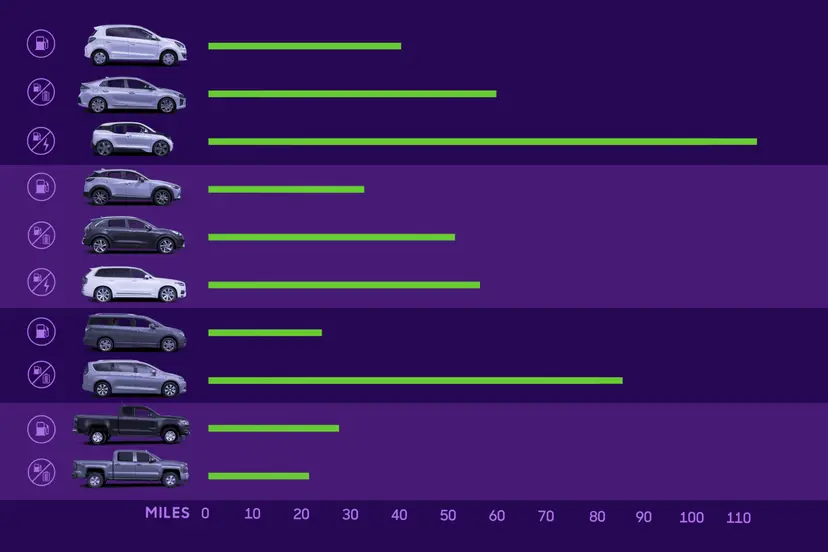
The rebirth of the Chevrolet Colorado and GMC Canyon has been a boon to GM pickup truck sales, adding volume and customers to the truck side of the showroom as gasoline remains cheap and plentiful. Now entering its third model year, the Canyon gains two things: a Denali top trim level and a new eight-speed automatic transmission.
Before the Denali showed up, the fanciest Canyon you could get was the SLT model, which I drove in diesel form in the summer of 2016 to pull a 22-foot Airstream trailer. An SLE model won our 2016 Midsize Pickup Challenge, besting every other mid-size pickup in the category, including the new Honda Ridgeline. So how does the new top luxury model stack up to the field?
Exterior and Styling
The changes that make the Canyon into a Denali are subtle, maybe too subtle. The idea behind the full-size GMC Yukon Denali SUV always has been to provide Cadillac Escalade levels of luxury without the ostentatious styling and exorbitant price. That philosophy carries over here, with the GMC Canyon Denali receiving a chrome grille and tubular side steps, unique wheels and a standard spray-in bedliner. If you aren’t paying close attention to the grille, you wouldn’t know that this is anything other than a nice Canyon; the Denali chrome additions aren’t all that extraordinary. It’s still a very good looking truck, but it merely looks a little different from the SLT trim, not more luxurious or expensive.
How It Drives
The 3.6-liter V-6 engine powering the 2017 GMC Canyon is actually different from the 3.6-liter under the hood of the 2016, though it has the same displacement and similar output and fuel economy. The engine is a version of the one that debuted in the new Camaro. Suffice it to say that it behaves like the old one, with smoothness and power that’s welcome, and missing from some competitors such as the V-6 in the Toyota Tacoma. The engine gains 3 horsepower over the 2016 model, bringing it to 308 hp, and ups torque by 6 pounds-feet for 275 pounds-feet. It also adds variable valve timing, cylinder deactivation and a few other refinements that you’ll likely never notice. Unlike the Camaro, it does not feature a stop-start function.
More notable is the addition of the new eight-speed automatic, which is geared differently from the old six-speed and brings a newfound sprightliness to the Canyon’s performance. The GMC Canyon feels quicker off the line, more eager to pass on the highway and just more responsive in general. On the highway, those two extra gears enable the Canyon to cruise more quietly, with the engine ticking over at just about 1,200-1,300 rpm, enabling a calm and relatively noise-free cruising speed. There’s more wind noise than engine noise at speed, and the same civilized, well-damped, comfortable ride that we remember from other models remains.
Fuel economy is the big question with this new 3.6-liter motor and eight-speed automatic, and turning to the EPA for answers isn’t going to help: The agency changed the test methodology from 2016 to 2017, so it appears as if the Canyon lost 1 mpg in its combined ratings. GM also says that it’s retuned the overall powertrain combination for better drivability, which can sometimes impinge on overall fuel economy (It’s a balance, after all). Thankfully, we did real-world fuel economy testing with the ’16 back in our 2016 Midsize Pickup Challenge, where the ’16 GMC Canyon SLE turned in a 22.0-mpg average over a 165-mile loop of mixed city and highway driving. That same loop run with the ’17 Canyon Denali in nearly identical conditions turned in an observed 20.5-mpg performance.
This worse performance may be due to the additional weight the GMC Canyon Denali carries over the SLE — the ’16 SLE crew cab 4×4 short bed weighed an observed 4,440 pounds, while the ’17 Denali tipped the local scales at 4,620 pounds. It could be due to a different final gearing or the different engine tuning that makes the 2017 Canyon more fun and responsive to drive. Still, with the powertrain changes, I expected the GMC Canyon Denali to turn in a better fuel-economy performance than it did. If fuel economy is important to you, perhaps the 2.8-liter Duramax diesel engine would be a better option — I recorded an observed 28.8 mpg in that configuration in 2016.
Interior
The Denali line is supposed to be the top luxury trim for the GMC brand, but the Canyon version doesn’t feel any more luxurious than the SLT I tested a few months prior or all that different from the SLE I drove not long before that. This could be because there isn’t all that much that’s different inside — GMC has added a leather interior in Jet Black with heated and ventilated seats (exclusive to the Denali trim), some unique dashboard trim, and Denali logo sill plates and floormats. The rest of the Denali goodies come in the form of equipment that can be had as options on lesser trims but are standard at this level, such as a heated steering wheel, a navigation system with an 8-inch touchscreen, automatic climate control, Bose audio system and more. It’s nice, but it’s not special.
Like the rest of the Canyon range, the GMC Canyon Denali is comfortable and well-appointed, with decent interior materials quality and excellent outward visibility. The front seats are supportive and properly adjustable, but legroom is still a bit tight in the backseat. This isn’t a full-size pickup, despite it being within a few inches of full-size pickups from the 1990s. Headroom is plentiful, unlike in the Tacoma, and there’s plenty of width in the cabin, unlike in the Nissan Frontier. You could use a Canyon as a daily driver without any compromise in comfort, making it somewhat of a more sensible choice than the larger Sierra for a weekend-warrior pickup buyer.
Ergonomics and Electronics
The Denali trim comes standard with the 8-inch touchscreen and GMC’s IntelliLink multimedia system. Navigation is also part of the package. It’s an intuitive, easy-to-use system that works quickly and features voice controls that are also without fault. If you prefer a more standardized system, the screen can instead employ Apple CarPlay or Android Auto for fans of those systems. The standard IntelliLink system is considerably more user-friendly than the Toyota Entune system, and at least two generations newer than the ancient system Nissan employs in the equally ancient Frontier.
The gauges in front of the driver are clear, bright and easily legible, while an electronic information screen resides between them that offers all kinds of extra info, controlled by two five-way switches on the steering wheel. The Denali trim comes pretty much loaded with everything you could possibly specify on the Canyon options sheet, including a heated steering wheel and two USB ports up front for personal device connectivity. Onboard 4G LTE Wi-Fi is also standard on the Denali trim.
Cargo and Towing
I didn’t do any towing with this version of the new Canyon, so we’ll have to wait for a later report on how the new eight-speed automatic does with a load behind the bumper. The new V-6 and eight-speed keeps the tow rating of the old model, however, enabling the Canyon Denali to drag a trailer of up to 7,000 pounds (if you want more, opt for the 2.8-liter turbocharged four-cylinder Duramax diesel, which will get you 7,700 pounds). In terms of cargo, you’re presented with two potential bed lengths for the Canyon (5-foot or 6-foot), and the Denali trim can be had with either of them.
In the cabin, there are plenty of storage cubbies and places to stash electronics, knickknacks, tissue boxes or burger wrappers. The rear seats also fold up to allow for more bulky items to be placed behind the front seats if you’re carrying something that you don’t want to leave exposed to the elements.
Safety
Pickup trucks can be problematic when it comes to crash safety. The Insurance Institute for Highway Safety has rated the Canyon crew cab as good (out of a possible good, acceptable, fair or poor) in the moderate front overlap test, and rates its front crash prevention as basic (out of a possible not available, basic, advanced or superior) thanks to its available forward collision warning system (standard on Denali) but no automatic emergency braking. But something the IIHS has noted is the headlight performance rating, which it says is poor — actually some of the worst headlights on the market in terms of illumination and distance. Note that all models in the IIHS’ small pickups class carry poor headlight ratings and similarly haven’t been subjected to the full suite of crash tests. The Ridgeline, which IIHS classifies as a full-size truck, boasts the best ratings across the board in this comprehensively tested class.
The National Highway Safety Administration gives the Canyon four stars overall, with four stars in frontal crash performance, five stars for side impact and only three stars in rollover testing. The Colorado 4×2 and 4×4 along with the Frontier 4×2 rate three stars for rollovers, while the Frontier 4×4 rates four stars, as do the Tacoma and Ridgeline.
Unlike other traditional mid-size pickups, the Canyon has a few optional electronic safety systems that set it apart. The Canyon Denali comes with class-exclusive forward collision warning and lane departure warning, but it still lacks a blind spot monitor or parking sensors, features available on the Ridgeline.
Value in Its Class
The Denali version of the GMC Canyon pretty much comes loaded, starting at $43,815 (all prices include destination) for my short-box 4×4 model. My single option was slate gray metallic paint for $395, bringing the grand total to $44,210. You can specify other configurations for the Denali, such as the long box or diesel engine, or skip the four-wheel drive and stick with rear-wheel drive. Add it all up, and you can easily top fifty grand for one if you start adding accessories such as bed extenders and tonneau covers.
The competing mid-size pickups also have luxurious trim levels, with the Ridgeline’s top Black Edition starting at a comparable $43,910 and coming just as loaded as a Denali. It features full-time all-wheel drive with a front-wheel bias, based as it is on a modified Honda Pilot SUV platform. It doesn’t have quite the carrying capacity or off-road ability of the more true-to-form pickup, but it does come with some novel features such as a bed that turns into a huge reverberating speaker and a lockable bed “trunk.” The Tacoma also has a luxury-minded Limited model starting at $39,955 for a double cab 4×4 model, but the Tacoma’s anemic V-6 and cramped interior are what kept it from being more competitive in our last big Challenge. Compare all four models here.
At the end of the day, GMC has created another version of the Canyon, but not one that’s appreciably better than the SLT or SLE trims. With the new powertrain available across the range, the only reason to opt for the Canyon Denali is for the minor styling or all-inclusive option packaging.
Cars.com’s Editorial department is your source for automotive news and reviews. In line with Cars.com’s long-standing ethics policy, editors and reviewers don’t accept gifts or free trips from automakers. The Editorial department is independent of Cars.com’s advertising, sales and sponsored content departments.

























































